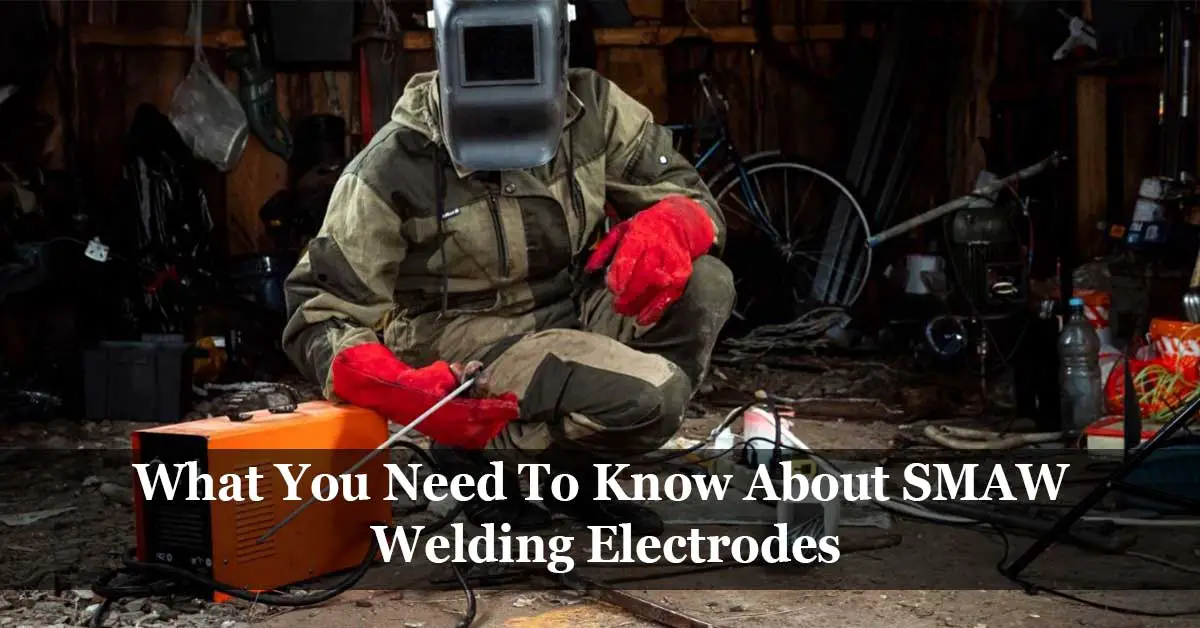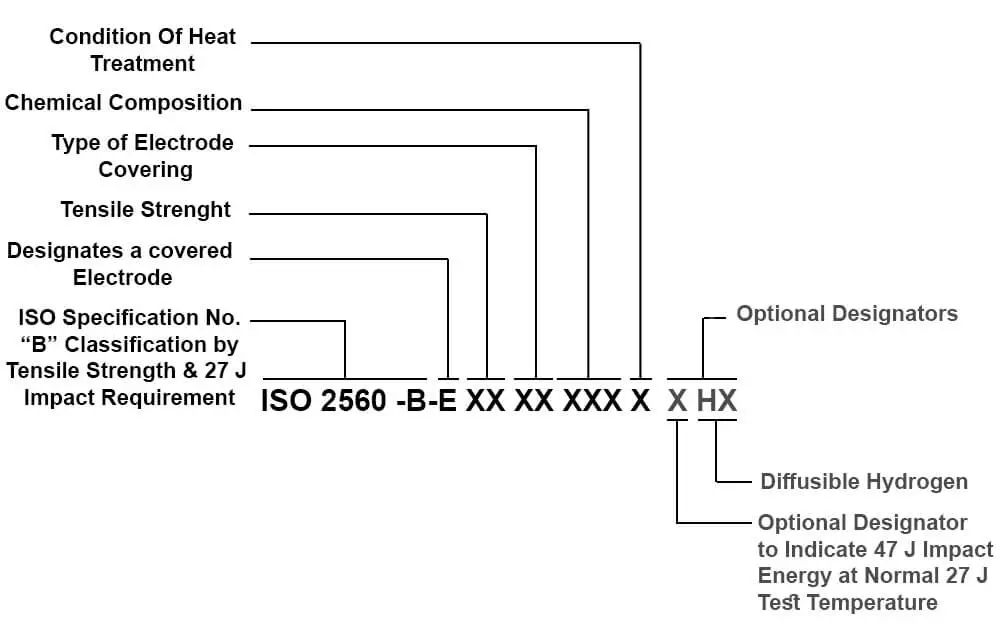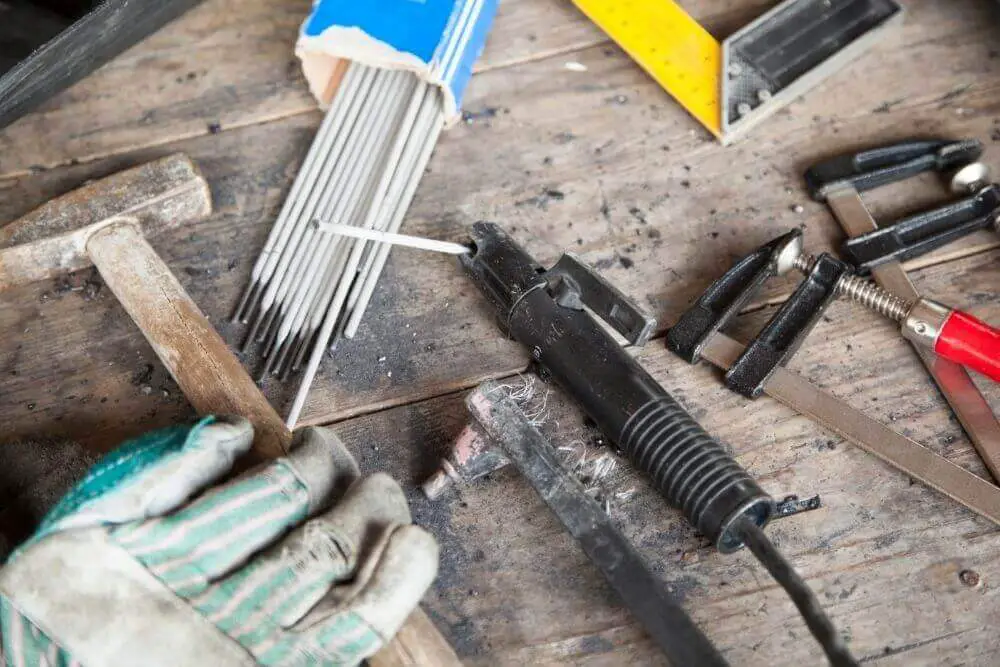Welding electrodes for shielded metal arc welding (SMAW) or stick welding, as they are known, consist of a core wire covered with what is called flux coating. The wire is made of low-quality steel, and the properties of the deposited metal are then enhanced by the refining additives included in the flux coating.
Welding Electrodes Flux Coating
The flux coating contains metallic and non-metallic components that are added to enhance specific properties of the weld joint. The flux coating plays a vital role in arc stabilization, produces shielding gas which protects the welding arc and molten metal from contamination by air, produce slag which protects the weld metal, control hydrogen content, refine weld metal, added necessary alloying elements based on the welding application requirements, and helps in arc ignition.
For instance, manganese added to the flux coating as a component that improves the weld metal’s toughness and strength; besides, silicon added as a deoxidizing element that Interacts with the molten weld metal and forms oxide silica that removes oxygen from weld metal.
A metal powder is added to welding electrodes producing what we call Metal powder electrodes. Metal powder electrodes can handle higher welding current level. Therefore, it gives a higher metal deposition rate compared with an electrode containing no iron powder. The metal deposit rate increases, but at the same time, the arc force is reduced, which reduces bead penetration.
Metal powder electrodes increase the metal deposition rate up to 140%; however, using metal powder electrodes is limited to flat, horizontal, and vertical welding positions.
SMAW Electrodes Groups
As the flux coating enhances the properties and consequently the characteristics of the weld metal. The SMAW electrodes are grouped based on their flux coating type into three groups; the main three groups are:
- Basic.
- Rutile.
- Cellulosic.
Each type of flux coating has certain metallic and non-metallic components that significantly affect the weld properties.
Basic Coated Stick Electrodes
The basic electrode coating consists of about 80% of basic components, mainly calcium carbonate (CaCO3) and calcium fluorite (CaF2).
Basic Electrodes Properties
- The arc of basic coated stick electrodes contains little oxygen; therefore, the burn-out of alloying elements is low.
- High impact energy of the basic electrodes weld, especially at low temperatures.
- Basic coated stick electrodes produce highly elongable welding with a low weld metal yield point.
- High metallurgic purity of the welding on which reduces the risk of hot cracking.
- Lower amount of hydrogen on which reduces the risk of cold cracking.
- The basic coated stick electrode slag reacts with the metal impurities such as sulfur and phosphorus, which improves welds properties.
- The basic coated stick electrodes give clean weld metal, which improves the mechanical properties, especially toughness.
Basic Electrodes Points to Consider
- The welder should maintain a short arc during welding to avoid welding porosity.
- Basic coated stick electrodes slag is thick and viscous; hence, high welder skill is essential to produce welds without slag inclusions.
- Slag removal is more challenging with basic electrodes as the weld profile is convex in its shape.
- Basic coated stick electrodes require baking to minimize moisture content in the basic coating to have low hydrogen levels in weld-metal.
Basic Electrodes Uses
- Use for rigid constructions that require high elongable weld with low weld metal yield point.
- Use for welding different grades of steel, including higher-strength steel.
- Use for welding contaminated steel and steel with high sulfur and phosphorus content, which basic electrodes transfer all impurities into a slag.
- Use for welding applications that require high fracture toughness at low operating temperature.
- Use for shrinking parts and components.
Basic Electrodes Baking Procedure
Manufacturing SMAW electrodes produce electrodes with low moisture content as the electrodes pass through a baking process at a high temperature during production.
The electrodes are usually packed in sealed containers; the container should be kept in their unopened moisture controlled condition and stored in dry condition.
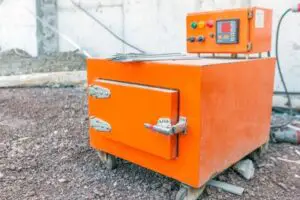
Once the container is opened, electrodes tend to absorb moisture, and then electrodes should be re-baked in an oven at 325ºC±25°C for one hour or 250~275ºC for two hours and then held in a holding oven at 150ºC before they are issued in quivers to the welders.
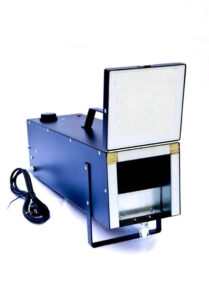
Usually, electrodes can be re-baked two or three times without affecting the integrity of the flux coating and welding performance; however, the manufacturer of the electrode will specify the maximum number of electrodes re-baking.
Basic coated stick electrodes are welded with direct current at the + pole (DC+) or with alternating current (AC).
Rutile Coated Stick Electrodes
The rutile electrode coating consists of about 90% of rutile components, mainly titanium dioxide (TiO2), reduced to 50% in carbon and carbon-manganese steel rutile electrodes.
Rutile Electrodes Types
Rutile electrodes are all-purpose electrodes, divided into categories based on electrode coating thickness and components mix type; the main types are:
R type – Thin coated large globular transfer, the electrode has a good bridging ability; therefore, the R electrodes are used for sheet metal welding.
RC type – Medium-thick welding and good viscous, the electrode are appropriate for vertical down welding.
RR type – Thick coated fine drooping transfer; the electrode produces high deposition and smooth welds.
RB types – Thick coated intermediate-sized coarse transfer, the electrode produces good toughness and strength welds better than RR types, high deposition efficiency. They are usually used in pipeline construction, structural steel engineering for joints fill-up, and root welding.
Rutile Electrodes Properties
- Rutile coated stick electrodes arc is very smooth and stable.
- Rutile coated stick electrodes arc has a less oxidising effect; the arc atmosphere is neutral.
- Rutile electrodes produce a smooth weld profile.
- Rutile electrodes produce thin slag layer that is easy to remove.
- Rutile electrodes are the easiest to use when comparing it with other electrode types.
Rutile Electrodes Points to Consider
- Rutile coated stick electrodes cannot be baked as they contain about 10% cellulose; therefore, they include relatively high moisture and produce high hydrogen welds.
- Rutile electrodes are not used for welding high strength steel or thick steel section because of the risk of cracking due to the produced high hydrogen welds.
- Rutile coated stick electrodes produce low toughness welds at low temperatures.
Rutile Electrodes Uses
- Rutile coated stick electrodes are used for general purpose fabrication of low strength unalloyed steel.
- Rutile electrodes are used to increase welding production rate by adding iron powder to the coating, which increases the metal deposition rate.
- Rutile coated stick electrodes are suitable for welding thin steel sections.
Rutile coated stick electrodes are welded with direct current at the – pole (DC-), direct current at the + pole (DC+) or with alternating current (AC).
Cellulose Coated Stick Electrodes
The cellulose stock electrode coating consists of about 40% of combusting substances (cellulose).
Cellulose Electrodes Properties
- Cellulose coated stick electrodes are used efficiently for vertical-down welding.
- Cellulose coated stick electrodes produce a high welding velocity at a high deposition rate.
- Cellulose electrodes coating breaks during welding producing carbon monoxide, carbon dioxide, and hydrogen which act as a shielding gas protecting the molten metal.
- The formed hydrogen from electrode coating melting produces relatively high arc voltage.
- Cellulose electrodes produce a good to excellent quality welding for secure circular seams (Pipelines).
- Cellulose electrodes produce a relatively small volume of slag.
Cellulose Electrodes Points to Consider
- Cellulose coated stick electrodes cannot be baked during the manufacturing or before welding as baking would destroy the cellulose; therefore, they include relatively high moisture and produce high hydrogen welds.
- Cellulose electrodes are associated with the risk of hydrogen cracking due to the produced high hydrogen welds.
- As a control measure, another weld pass to follow the cellulose electrode root pass while the weld bead is still hot to facilitate hydrogen escape and minimize the risk of hydrogen cracks. The second weld pass that was performed while the root pass is still hot is called (hot-pass).
- Cellulose electrodes are limited in use for welding high strength steel or thick steel section because of the risk of cracking due to the produced high hydrogen welds.
- Cellulose coated stick electrodes produce low toughness welds at low temperatures.
- Cellulose electrodes produce high smoke during welding; however, it does not distract when working in open spaces.
- A highly skilled welder is required during vertical-down position welding for a sound weld.
- A special vertical-down welding power supplies with very steep voltage regulation characteristics and no-load voltages of ≥ 80 have to be used.
- Joint proper fit-up is essential, with proper alignment of plate edges and constant root gap.
Cellulose Electrodes Uses
- Cellulose coated stick electrodes used in vertical-down welding at a faster speed and lower risk of lack of penetration and lack of fusion.
- Cellulose electrodes are the most suitable electrodes to perform root pass welding at high speed and good penetration.
- Cellulose stick electrodes are known for welding pipelines root pass with good penetration.
- Cellulose stick electrodes are used in welding vertical and circumferential joints on oil storage tanks.
Cellulose coated stick electrodes are welded with direct current at the + pole (DC+) or with alternating current (AC).
Classification of Welding Electrodes
Various international standards classify welding electrodes; European and American standards are the most common standards used for classifying electrodes. The electrode classification is based on the testing requirements identified by the standards on the weld deposits to verify that welds meet the mechanical properties and chemical composition requirements. Electrodes manufacturers tend to certify their electrodes by most of the international standards for broader usage.
The most common international standards classifying welding electrodes are:
- ISO 2560 – Welding consumables (Covered electrodes for manual metal arc welding of non-alloy and fine grain steels).
- AWS A5.1 – Specification for Carbon Steel Electrodes for Shielded Metal Arc Welding.
- AWS A5.5 – Specification for Low-Alloy Steel Electrodes for Shielded Metal Arc Welding.
ISO 2560 Classification
ISO 2560 Standard classifies covered electrodes for manual metal arc welding of non-alloy and fine grain steels; the standard is divided into two classification systems, System “A” and System “B” as follow:
- ISO 2560 Classification System “A”: Classification by yield strength and 47 J impact energy.
- ISO 2560 Classification System “B”: Classification by tensile strength and 27 J impact energy.
The electrode manufacturer prints a specific designation on each electrode to identify its properties and usage based on one of the two above systems.
ISO 2560 Classification System “A”
The designation is divided into compulsory and optional; in system “A” the designation compulsory includes yield strength, impact energy, chemical composition, and electrode coating type. The optional includes diffusible hydrogen content, welding position, and metal recovery, and type of current.
The compulsory sections must be identified and printed on the electrodes, while optional sections are not mandatory and may not be shown on all electrodes.
ISO 2560 Classification System “B”
The designation is divided into compulsory and optional; in system “B” the designation compulsory includes tensile strength, type of electrode coating, chemical composition, and heat treatment condition. The optional includes diffusible hydrogen content and 47 J impact energy at the normal 27 J test temperature.
The compulsory sections must be identified and printed on the electrodes, while optional sections are not mandatory and may not be shown on all electrodes.
AWS A 5.1 and AWS A5.5
AWS A5.1 and A5.5 Standards classify carbon steel electrodes and low-alloy steel electrodes for shielded metal arc welding. The electrode’s designation is divided into mandatory and supplementary; both mandatory and supplementary designators have to be printed on each electrode as per classification system requirements.
Each digit of the electrode designation is used to designate a specific requirement of the standard as follow:
E – Electrode
Tensile and Yield Strength – in PSI of the weld metal
- E60xx – Tensile Strength of 60,000 psi
- E70xx – Tensile Strength of 70,000 psi
- E80xx – Tensile Strength of 80,000 psi
- E90xx – Tensile Strength of 90,000 psi
- E100xx – Tensile Strength of 100,000 psi
- E110xx – Tensile Strength of 110,000 psi
- E120xx – Tensile Strength of 120,000 psi
Welding Positions
- Exx1x Flat, Horizontal, Vertical (up), Overhead.
- Exx2x Flat, Horizontal.
- Exx3x Flat.
- Exx4x Flat, Horizontal, Overhead, Vertical (down).
Electrode Coating
- Exxx0 – Cellulose, Sodium
- Exxx1 – Cellulose, Potassium
- Exxx2 – Rutile, Sodium
- Exxx3 – Rutile, Potassium
- Exxx4 – Rutile, Iron Powder
- Exxx5 – Low Hydrogen, Sodium
- Exxx6 – Low Hydrogen, Potassium
- Exxx7 – Iron Powder, Iron Oxide
- Exxx8 – Low Hydrogen, Iron Powder
- Exxx9 – Iron Oxide, Rutile, Potassium
Electrode Current and Penetration
- Exxx0 – DC+ (Deep Penetration)
- Exxx1 – AC/DC+ (Deep Penetration)
- Exxx2 – AC/DC- (Medium Penetration)
- Exxx3 – AC/DC+/DC- (Light Penetration)
- Exxx4 – AC/DC+/DC- (Medium Penetration)
- Exxx5 – DC+ (Medium Penetration)
- Exxx6 – AC/DC+ (Medium Penetration)
- Exxx7 – AC/DC- (Medium Penetration)
- Exxx8 – AC/DC+ (Medium Penetration)
- Exxx9 – AC/DC+/DC- (Medium Penetration)
Additional Requirements as per AWS A5.1
- (1) – Means increased toughness for E7018 electrodes or increased ductility for E7024 electrodes.
- (M) – Means electrode meets most military requirements; military requirements are usually greater toughness, lower moisture content, and specific diffusible hydrogen limits for weld metal.
- (H4), (H8), or (H16) – Indicates the maximum diffusible hydrogen limit measured in millimeters per 100 grams (mL/100g).
- H4 means 4mL per 100 grams.
- H8 means 8mL per 100 grams.
- H16 means 16mL per 100 grams.
Additional Requirements as per AWS A5.5
- (A1) – Steel Alloy Type: Carbon-Molybdenum.
- (B1) / (B2) / (B2L) / (B3) / (B3L) / (B4L) / (B5) / (B6) / (B8) – Steel Alloy Type: Chromium-Molybdenum with different percent.
- (C1) / (C1L) / (C2) / (C2L) / (C3) – Steel Alloy Type: Nickel Steel with different percent.
- (NM) – Steel Alloy Type: Nickel-Molybdenum.
- (D1) / (D2) / (D3) – Steel Alloy Type: Manganese-Molybdenum.
- (W) – Weathering steel.
- (G) – No required chemistry.
- (M) – Military grade.
Related Article: A Guide To 6010, 6011, 6013, And 7018 Welding Rods
Welding Electrodes Deposition Rate
The deposition rate of welding electrode is the rate that molten metal from weld can be deposited expressed in grams, kilograms or pounds per hour. The calculation is based on continuous operation, with excluding the stoppage time consumed during inserting a new electrode, cleaning slag, or any other external reasons.
Welding Electrodes Inspection
Welding electrodes inspection before usage is essential to avoid weld defects that may result from using electrodes that does not meet the requirements; the following points usually are verified:
Electrode size
Electrode diameter and length have to meet the order requirements, typically 350-450mm length and 2.5-6mm electrode diameter; however, other lengths and diameters are available.
Electrode Coating Condition
Flux coating has to free from cracks and chips; steel core wire has to be concentric with equal coating thickness and proper adherence between the coating and the wire core is essential.
Electrode Designation
Electrode designation should meet welding project requirements, and hence it is essential to verify that the following designations and make sure they match welding joint requirements.
- Material: Various welding electrode materials are available based on the base metal material; the electrodes come in low carbon steel, high carbon steel, cast iron, special alloys, etc.
- Strength and toughness: Electrodes yield, tensile strengths, and toughness vary based on the weld joint strength requirement.
- Chemical composition: chemical composition of the weld metal that tends to improve the characteristic of the weld joint.
- Iron powder content: Iron powder content in the coating to enhance metal deposition and productivity; however, it limits welding positions.
- Welding position: Different electrodes are used for different welding positions.
Welding Electrodes Operation Variables
During welding, various variables are affecting welding electrodes, and the welder controls those variables, the variables are:
- Current (Amperage): Amperage is determined by the size of the electrode and welding position, the electrode manufacturer specifies the recommended amperage value. Low amperage produces irregular weld bead shape and lack of fusion and penetration. High amperage results in excessive penetration, burn through, undercut, and may damage the electrode due to overheating.
- Arc length (Voltage): The welder control the arc length during welding by maintaining the distance between the welding electrode and base metal and therefore controls the arc voltage, arc voltage is the voltage required to maintain the arc during welding. The low voltage causes poor penetration, slag inclusion, and unstable arc. The high voltage generates excessive spatter and cause porosity and irregular weld bead shape.
- Travel speed: Depending on performing the welding by stringer beads or by weaving, the length of weld deposit from one standard electrode is called Runout Length (ROL) and it is defined in the welding procedure specification (WPS). Fast travel speed produces narrow weld bead, slag inclusion and poor fusion and penetration. Slow travel speed produces irregular weld bead shape, excessive deposited weld, and cold lap.
- Angle of travel: Depending on welding position electrode angle is set. Trailing, vertical or leading are the known travelling angle position that affects weld penetration and metal deposition.
- Manipulation: Welding manipulation techniques vary between welders; the technique depends on electrode type, current, welding position, welding pass type (root, fill-up or cap), and joint design.
Type of Current for Welding Electrodes
Direct Current – Electrode Positive (DC+)
The welding electrode is the positive pole in the welding circuit, and the base metal is the negative pole. The heat generated by welding distributes to two thirds on the electrode tip and one third on the base metal.
Direct Current – Electrode Negative (DC-)
The welding electrode is the negative pole in the welding circuit, and the base metal is the positive pole. The heat generated by welding distributes to one third on the electrode tip and two thirds on the base metal.
Alternating Current (AC)
The current is alternating between the welding electrode and the base metal. The heat generated by welding is distributed equally between the electrode tip and base metal.
References:
- TWI-Global: The Welding Institute (Various publications).
- American Welding Society (AWS A5.1 – A5.5).
- International Organization for Standardization (ISO 2560).
- Lincoln Electric: The procedure Handbook of Arc Welding.

